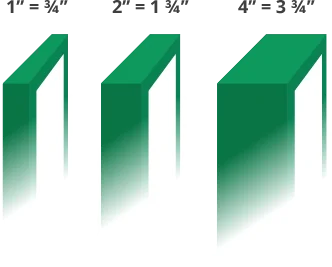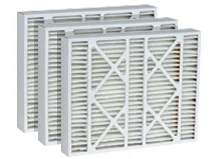Cleaner Air, Happier Home: The Filter Choice That's Right for You
The right air filter can genuinely elevate your home's comfort.
If allergies turn your home into a sneeze-fest, pleated filters could be your saving grace. They snag even the tiniest irritants, giving you cleaner air to breathe easily. While they cost more, their longevity means fewer replacements and fresher air throughout the year.
For a more budget-friendly option, non-pleated filters offer better airflow and ease of use on your HVAC system. While they don't trap the tiniest particles, they're great for homes without major allergy concerns, balancing cost and performance.
In the end, selecting the right filter can significantly improve your indoor comfort and the performance of your HVAC system. Curious to learn more about finding the ideal filter for your needs? Keep reading to explore the options in detail.
Key Points at a Glance
- Although pleated air filters have a higher initial cost, their larger surface area captures more particles, making them suitable for homes concerned about allergens.
- Non-pleated filters offer a budget-friendly option, require less upkeep, and work well for households without significant allergy or air quality issues.
- Evaluating your HVAC system's specifications helps determine whether pleated or non-pleated filters are better for your needs.
- Both filters have different maintenance requirements and lifespans; pleated options typically last longer but need more attention.
- Balancing budget limitations and air quality preferences is essential when selecting between pleated and non-pleated air filters.
Filtering Through the Options
It's best to acquire the proper knowledge about which air filter is best for your system. There are options, so it's vital to know them.
Fiberglass filters are the go-to for many to save some cash. Designed primarily to protect HVAC equipment, they capture only larger dust particles. For those worried about allergies or asthma, this option may fall short.
Pleated filters, in contrast, effectively trap smaller particles, significantly enhancing indoor air quality. Although pricier than fiberglass, investing in pleated filters benefits health and air purity.
Another possibility includes activated carbon filters, which eliminate odors and harmful chemicals. Such filters suit environments near busy roads or in densely populated areas.
Choosing an appropriate filter involves balancing budget constraints, HVAC system specifications, and air quality needs. This decision warrants careful consideration, so take your time.

Pleated Air Filters: What Sets Them Apart
When weighing your options, pleated air filters might be just what you want. Thanks to their unique design, their standout feature is efficiency. The pleats create an extra surface area, allowing them to capture more dust, pollen, and airborne particles than standard flat filters. This added capacity means cleaner air in your home and a more effective barrier against irritants.
Pleated filters are durable and practical. Typically constructed from synthetic materials, they resist wear while maintaining performance. You won't need to change them as often as you might expect, which can save time and effort.
Maintenance is simple. Check the pleated air filter regularly, ideally once a month. If dirt is visible, it's time for a replacement. Some versions are reusable; simply vacuum or rinse, allow to dry, and reinsert.
Pleated air filters might come with a higher price tag, but many homeowners find the extra cost worth it for the improved performance and durability. Their ability to trap more particles and last longer adds value over time. Ultimately, the best filter choice comes down to your needs and what works best for your home.
Efficiency in Simplicity: Non-Pleated Filters
Non-pleated air filters offer a few perks. The biggest win? Cost savings. These filters are generally more budget-friendly than pleated ones, making the upfront and replacement costs easier to handle. While they need to be swapped out more frequently—usually every month—they keep expenses manageable without sacrificing essential air filtration.
Airflow resistance is another benefit. Non-pleated designs allow for more effortless airflow, reducing strain on HVAC systems. This can enhance system longevity and lower maintenance needs.
Non-pleated filters might not catch every speck of dust, but they’re great at capturing the larger particles like dust, lint, and hair that can clutter your home. For families without allergy or respiratory concerns, they get the job done, keeping things simple and clean without extra effort. They’re a reliable and straightforward option for maintaining a fresher living space.
Drawbacks of Both Filter Types
Both pleated and non-pleated air filters have their drawbacks.
First, consider filter lifespan. Pleated filters usually outlast non-pleated options but come with a higher initial cost. Non-pleated filters may need more frequent replacements, leading to increased expenses over time.
Maintenance is essential to think about. Pleated filters can be harder to clean with all their folds, while non-pleated ones gather dust faster, so you'll need to clean them more often. Just choose the one that fits your routine best.
Things to keep in mind: The downsides
- Higher initial cost for pleated filters
- Shorter lifespan for non-pleated options
- Cleaning pleated filters can be more challenging
- Non-pleated filters require more frequent cleanings
- Potential for higher long-term costs with non-pleated filters
Consider these factors when selecting the right filter type for your home.
The Smart Choice for a Healthier Home
You breathe through the door, and the air feels refreshingly clean. That's the magic of the right air filter at work. If allergies or dust constantly disrupts your space, pleated filters are like your personal air warriors. They scoop up those tiny irritants, keeping your home's air fresher. Sure, they ask for a little more attention, but they give back in the comfort of clean, breathable air.
On the flip side, maybe you're someone who doesn't want to fuss with filter changes too often. Non-pleated filters quietly do their job, keeping things simple while helping your HVAC system run smoothly. They may not catch every speck, but they're reliable and easygoing for homes without heavy air quality concerns.
Choosing a filter is really about what works for your life. Do you need that extra defense against allergens, or is ease and simplicity more your speed? Either way, your home will feel better, and so will you.

Frequently Asked Questions
Which is better, pleated or non-pleated air filters?
Due to their larger surface area, pleated filters are better at trapping particles like dust, pollen, and pet dander. They improve air quality and reduce strain on your HVAC system. Non-pleated filters are cheaper but less effective at capturing smaller particles. If air quality matters, go with pleated filters.
What is the main advantage of a pleated filter?
The most significant benefit is better filtration. The pleats increase the surface area, capturing more dust and allergens, which helps improve indoor air quality and keeps your HVAC system running efficiently.
Do pleated filters restrict airflow?
Pleated filters can restrict airflow slightly more than non-pleated ones, but they balance filtration and airflow. Choosing the right MERV rating (between 8 and 13) ensures your system gets proper airflow while still effectively filtering the air.
How do I know if my air filter is pleated?
If your filter has visible folds or ridges, it's pleated. You can also check the packaging or label for the word "pleated" or look for a crinkled design.
How long do pleated air filters last?
Pleated filters usually last 3 to 6 months, depending on your home's air quality and how often your HVAC system runs. Homes with pets or lots of dust might need more frequent changes. Check for dust buildup to know when it's time for a replacement.
What are three different types of air filters?
Three common types are HEPA, pleated, and electrostatic filters. HEPA filters capture 99.97% of particles, making them ideal for allergy sufferers. Pleated filters are effective for most homes. Electrostatic filters use static electricity to attract particles and can be cleaned and reused.
Which type of filter is the best?
It depends on your needs. Pleated filters are great for most homes. If you have allergies, go for HEPA filters. Ensure that the filter you choose works with your HVAC system.
What is the MERV rating of a pleated filter?
Pleated filters typically have MERV ratings between 8 and 13. Higher ratings mean better filtration. Some high-efficiency pleated filters can have MERV ratings up to 16.
What air filters do not restrict airflow?
Electrostatic and washable filters allow for better airflow while still offering decent filtration. They are ideal for maintaining strong airflow without compromising on basic filtration.
What MERV rating is best for home use?
A MERV rating between 8 and 13 is ideal for most homes. This range captures common allergens without restricting airflow. If you want higher filtration, check that your HVAC system can handle a higher MERV rating.
Which filter is best for AC?
Pleated filters with a MERV rating of 8 to 13 are best for AC systems. They capture particles while allowing enough airflow to keep your AC running efficiently. Always make sure the filter is compatible with your AC unit.
What filter should I use for HVAC?
For most HVAC systems, pleated filters with a MERV rating between 8 and 13 work well. They filter out particles without blocking airflow. Always check your HVAC system's recommendations to pick the right filter.

.webp)
.webp)
.webp)
.webp)







